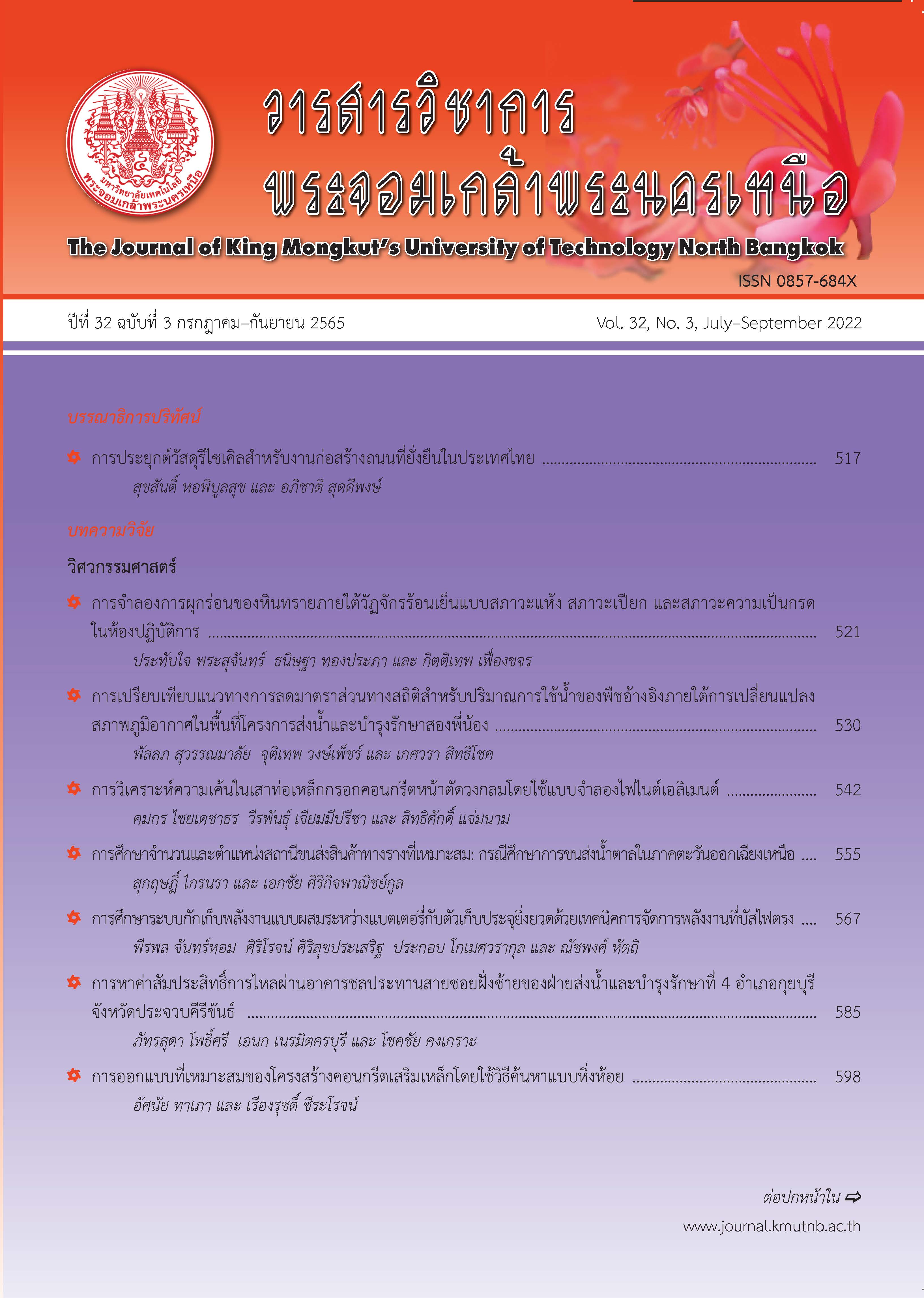Optimum Design of Reinforced Concrete Structures by Firefly Algorithm
Main Article Content
Abstract
This research presents the application of firefly algorithm for the optimum design of reinforced concrete frames. The total cost is defined as an objective to determine the most economical design of reinforced concrete frames. The firefly algorithm for the optimum design was implemented using Visual basic language whereas ACI318-14 standards were applied to check the design results. In addition, important parameters of the firefly algorithm were tested for the maximum efficiency. From the result, the firefly algorithm can be applied for the optimum design of reinforced concrete frames. Using the maximum iterations of 200 times and firefly population of 125, the ideal statistical values along with the greatest usage suitability were obtained. Moreover, the optimum solution of firefly algorithm proves to be more economical than other methods for comparing the efficiency of every sample.
Article Details

This work is licensed under a Creative Commons Attribution-NonCommercial-NoDerivatives 4.0 International License.
The articles published are the opinion of the author only. The author is responsible for any legal consequences. That may arise from that article.
References
J. Senthilnath, S. N. Omkar, and V. Mani, “Clustering using firefly algorithm: Performance study,” Swarm and Evolutionary Computation, vol. 1, no. 3, pp. 164–171, 2011.
X. S. Yang, “Firefly algorithms for multimodal optimization,” Lecture Notes in Computer Sciences, vol. 5792, no. 1, pp. 169–178, 2010.
J. Senthilnath, S. N. Omkar, and V. Mani, “Clustering using firefly algorithm: Performance study,” Swarm and Evolutionary Computation, vol. 1, no. 3, pp. 164–171, 2011.
M. H. Horng, “Vector quantization using the firefly algorithm for image compression,” Expert Systems with Applications, vol. 39, no. 1, pp. 1078–1091, 2012.
L. F. Miguel, R. H. Lopez, and L. F. Miguel, “Multimodal size, shape, and topology optimisation of truss structures using the firefly algorithm,” Advances in Engineering Software, vol. 56, no. 1, pp. 23–37, 2013.
P. Balachennaiah, M. Suryakalavathi, and P. Nagendra, “Optimizing real power loss and voltage stability limit of a large transmission network using firefly algorithm,” Engineering Science and Technology, an International Journal, vol. 19, no. 2, pp. 800–810, 2016.
H. Ghorbani, J. Moghadasi, and D. A. Wood, “Prediction of gas flow rates from gas condensate reservoirs through wellhead chokes using a firefly optimization algorithm,” Journal of Natural Gas Science and Engineering, vol. 45, no. 1, pp. 256–271, 2017.
B. K. Patle, A. Pandey, A. Jagadeesh, and D. R. Parhi, “Path planning in uncertain environment by using firefly algorithm,” Defence Technology, vol. 14, no. 6, pp. 691–701, 2018.
L. Jain and R. Katarya, “Discover opinion leader in online social network using firefly algorithm,” Expert Systems with Applications, vol. 122, no. 15, pp. 1–15, 2019.
American Concrete Institute (ACI), “Building code requirements for structural concrete and commentary,” in Structural Building Code, American Concrete Institute, 1st ed. Farmington Hills, MI, USA, 2014.
Basic education commission. Accounting of construction and labor costs in fiscal year 2019, 1st ed. Bangkok, 2019 (in Thai).
A. Kaveh and O. Sabzi, “A comparative study of two meta-heuristic algorithms for optimum design of reinforced concrete frames,” International Journal of Civil Engineering, vol. 9, no. 3, pp. 193–206, 2011.
A. Tapao and R. Cheerarot, “Optimum design of reinforced concrete foundations by fruit fly optimization algorithm,” The Journal of KMUTNB, vol. 31, no. 1, pp. 16–24, 2021 (in Thai).
